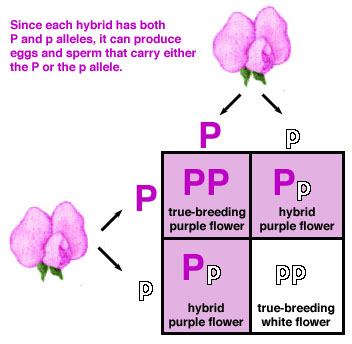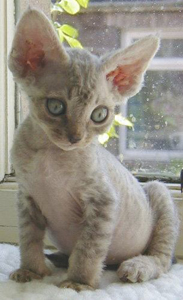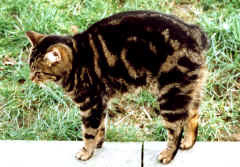BIOL 1400 -- Lecture Outline 17
"Facts do not cease to exist because they are ignored ." --Aldous Huxley
I. More on Mendel
- Mendel's work was forgotten during his lifetime, but it was rediscovered by
several scientists in 1900.
- Mendel's discoveries -- that "genes" come in pairs and are "shuffled" independently --
seemed to match what had been discovered about meiosis!
- Remember that chromosomes come in pairs and are "shuffled" at meiosis. . .
- Just as each parent contributes one of each chromosome to each offspring,
each parent contributes one of each allele to each offspring. . .
- This made a stronger circumstantial case that genes were carried on chromosomes!
- In the 1910s, Thomas Hunt Morgan and his students at Columbia University,
studying genetics in fruit flies, worked out that:
- Genes aren't the same as chromosomes. (Fruit flies have thousands of genes but only four pairs of chromosomes.)
- But genes are carried on chromosomes. Genes are, physically, parts of chromosomes. Keep this in mind. . .
- Some years after Mendel's work was rediscovered, a British geneticist named
R. H. Punnett developed a simple way of working out the expected frequencies of
any cross. This is the Punnett square.
- This rather colorful 2x2 Punnett square shows how to predict the results of Mendel's
Pp x Pp cross:

Three out of every four offspring from this cross will have purple flowers.
- In a similar way, with a 4x4 Punnett square, we can work out a cross between
organisms with two traits of interest (a dihybrid cross). You will see this
in lecture and lab. . .
II. Complications of Mendel's Laws
- When Mendel's work was rediscovered, and other scientists began doing similar
crosses to Mendel's, they discovered some features of inheritance that Mendel hadn't.
- When a dominant allele doesn't completely mask a recessive allele, we have
incomplete dominance .
- EXAMPLE: If you cross red snapdragon flowers (RR) with
white snapdragons (rr), the F1 offspring (Rr) are pink.
- This looks like "blending inheritance" -- but if you then cross two pink
snapdragons (Rr x Rr) you get one red (RR) for every two pink (Rr) and one white
(rr).
- In other cases, there may be codominant alleles
- If two different codominant alleles are present, the organism just shows
both traits, and neither one masks the other.
- EXAMPLE: Human ABO blood types are governed by a gene with three alleles.
Technically they're written IA, IB, and
i, but you can call them A, B and O. . .
- A and B are codominant and O is recessive. If you have an A and a B allele,
you have blood type AB.
- These alleles determine which molecular "dogtags" your blood cells carry:
type A, type B, both (AB), or neither (O). Your immune system attacks whichever
one you don't make: if you have type A blood, you will attack any blood cells
that are carrying the B tag (i.e., type B or type AB blood).
- People with type AB blood attack neither A nor B blood -- they are
universal recipients because they can accept blood from anybody
- People with type O blood have no "dogtags" -- they are universal
donors because anybody can accept blood from them.
- Multiple genes may influence one trait. This is called epistasis.
- EXAMPLE: Human height and skin color are inherited, but in each case something
like six different genes influence the actual outcome.
- EXAMPLE: The color and pattern of a cat's fur is affected by about ten
genes, each of which exists in several alleles. (I will go into this in some detail
in lecture. . .)
- A single gene may have multiple effects -- a phenomenon called pleiotropy.
- EXAMPLE: The Devon Rex breed of cat has a single allele that has multiple
effects -- it gives it wavy or curly hair, and also a "pixie"-shaped face with big
eyes, wide cheekbones, and big ears. Devon Rex cats look like Yoda!
(Check 'em out. . .)

A Devon Rex cat.
- EXAMPLE: In humans, the genetic disorder Marfan's syndrome is caused by
a single dominant allele -- its effects include: tallness; long arms and legs; long
fingers; tendency to nearsightedness or other vision problems; tendency to develop
weak spots in the aorta.
- Some genes may be lethal when they are homozygous -- this can mess up
the Mendelian ratios.
- EXAMPLE: Manx cats are cats with no tails; the tailless allele (T) is dominant
to the normal, tailed allele (t).
- When you mate two Manx cats, the breed doesn't "breed true"; you get a mix of
tailed and tailless cats.
- What's more, you get only two Manx kittens for every tailed kitten. This is not
what Mendel would have predicted. . .
- The reason is that having two copies of the tailless allele causes a kitten
to die very early in development, and never be born. So crossing two Manx cats
(Tt x Tt) yields 1 TT (lethal) : 2 Tt (Manx) : 1 tt (normal).
(Check 'em out. . .)

A Manx cat.
Go to Previous Notes |
Return to Lecture Schedule |
Return to Syllabus |
Contact the Prof |
Go to Next Notes


